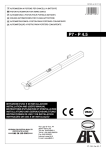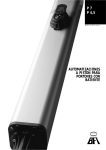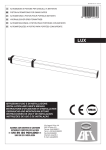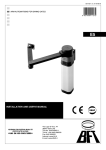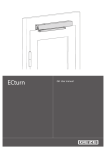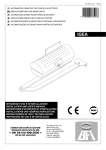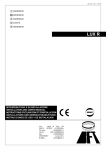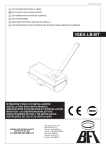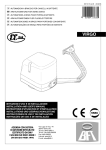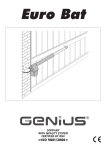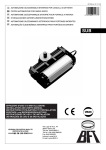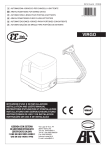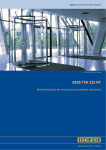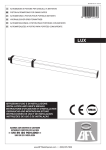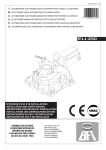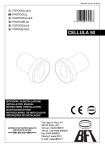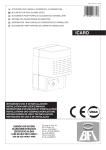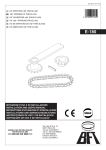Download P7 - P 4.5 - EasyGates Manuals & Guides
Transcript
D811223 ver. 03 07-11-00 I AUTOMAZIONI A PISTONE PER CANCELLI A BATTENTE GB PISTON AUTOMATION FOR SWING GATES F AUTOMATIONS A PISTON POUR PORTAILS BATTANTS 8 0 2 7 9 0 8 1 1 42 7 3 D KOLBEN AUTOMATIONEN FÜR FLÜGELGITTERTORE E AUTOMATIZACIONES A PISTON PARA PORTONES CON BATIENTE P AUTOMATIZAÇÃO A PISTÃO PARA PORTÕRS COM BATENTE P7 - P 4.5 ISTRUZIONI D'USO E DI INSTALLAZIONE INSTALLATION AND USER'S MANUAL INSTRUCTIONS D'UTILISATION ET D'INSTALLATION INSTALLATIONS-UND GEBRAUCHSANLEITUNG INSTRUCCIONES DE USO Y DE INSTALACION INSTRUÇÕES DE USO E DE INSTALAÇÃO Via Lago di Vico, 44 36015 Schio (VI) Tel.naz. 0445 696511 Tel.int. +39 0445 696533 Fax 0445 696522 Internet: www.bft.it E-mail: [email protected] P7 - P4.5 Ver. 03 - 1 ENGLISH INSTALLATION MANUAL Thank you for buying this product, our company is sure that you will be more than satisfied with the product’s performance. The product is supplied with a “Warnings” leaflet and an “Instruction booklet”. These should both be read carefully as they provide important information about safety, installation, operation and maintenance. This product complies with the recognised technical standards and safety regulations. We declare that this product is in conformity with the following European Directives: 89/336/EEC and 73/ 23/EEC and 98/37/EEC and following amendments. 1) GENERAL SAFETY WARNING! An incorrect installation or improper use of the product can cause damage to persons, animals or property. • The “Warnings” leaflet and the “Instruction booklet” supplied with this product should be read carefully as they provide important information about safety, installation, operation and maintenance. • Scrap packing materials (plastic, cardboard, polystyrene etc) according to the provisions set out by current standards. Keep nylon or polystyrene bags out of children’s reach. • Keep the instructions with the technical brochure for future reference. • This product was exclusively designed and manufactured for the use specified in the present documentation. Uses not specified in this documentation could cause damage to the product and be dangerous. • The Company declines all responsibility for any consequences resulting from the product being used improperly or differently from whatever is specified in the present documentation. • Do not install the product in an explosive environment. • The construction components of this product must comply with the following European Directives: 89/336/CEE, 73/23/EEC, 98/37 and following amendments. As for all non-EEC countries, the above mentioned standards as well as the current national standards should be respected in order to have a good safety level. • The Company declines all responsibility for any consequences resulting from failure to observe Good Technical Practice when constructing closing structures (door, gates etc.), as well as from any deformation which might occur during use. • The installation must comply with the provisions set out by the following European Directives: 89/336/CEE, 73/23/EEC, 98/37/EEC and following amendments. • Disconnect the electrical power supply before carrying out any operations on the plant. Also disconnect any buffer batteries, if fitted. • Fit an omnipolar circuit breaker or thermal magnetic circuit breaker on the mains power supply, having a contact opening distance equal to or greater than 3 mm. • Check that a differential switch with a 0.03A threshold is fitted just before the power supply mains. • Check that earthing is carried out correctly: connect all metal parts for closure (doors, gates etc.) and all system components provided, with an earth terminal. • Fit all the safety devices (photocells, electric edges etc.) which are needed to protect the area from any danger caused by squashing, conveying and shearing. • Position at least one light signal device (blinker) where it can be easily seen, and fix a Warning sign to the structure. • The Company declines all responsibility with respect to the automation safety and good operation when other manufacturers’ components are used. • Only use original parts for any maintenance or repair operation. • Do not modify the automation components, unless explicitly authorised by the Company. • Instruct the product user about the control systems provided and the manual opening operation in case of emergency. • Do not allow persons or children to remain in the automation operation area. • Keep radio control or other control devices out of children’s reach, in order to avoid unintentional automation activation. • The user must avoid any attempt to carry out work or repair on the automation system, but only request assistance from qualified personnel. • Anything which is not expressly provided for in the present instructions, is not allowed. 2) GENERAL OUTLINE A compact sturdy hydraulic piston, available in various versions according to the user’s requirements and type of operation. All models are supplied without locks (reversible), and an electric lock is required to keep them blocked. To make the manual manoeuvre easier, the lock can be released by means of a knob which can be reached using the appropriate key. The pushing force is adjusted with extreme precision by means of two bypass valves which provide antisquash safety. The end-of-stroke operation is electronically set in the control panel by means of a timer. All models are available with slow-down function during the closing phase. 12 - P7 - P4.5 Ver. 03 3) MAIN AUTOMATION PARTS (Fig.1) M) 2-pole single-phase motor, protected by thermal circuit-breaker. N) Hydraulic lobe pump. O) Distributor with adjustment valves. P) Cylinder with piston. CS) Rod cover. S) Tank. SB) Release. T) Head with slow-down adjustment valve. U) Base with articulated joint. Components supplied: Attachments for pillars and gate - personalised release key - drive capacitor - instruction manual. 4) TECHNICAL SPECIFICATIONS Mod. P7 - Mod. P4.5 Power supply ...................................................... 230Vac±10% - 50 Hz (*) Motor ........................................................................................... 2800min-1 Absorbed power ............................................................................... 250W Capacitor .............................................................................................. 8µF Absorbed current ................................................................................. 1.1A Max. pressure ............................................ 5MPa (50bar) - 4MPa (40bar) Pump capacity ............................................................... 0.6l/min - 0.9l/min Pushing force ..................................................................... 8000N - 6500N Towing force ...................................................................... 6500N - 5200N Opening time (working stroke) ................................................... 45s - 30s Closing time (working stroke) ............ 42s+slow-down - s 28s+slow-down Type of lock ............................................................................ Electric lock Max leaf length ......................................................................... 7m - 4.5m Max. leaf weight ................................................................ 5000N (~500kg) Working stroke ................................................................................ 390mm Slow-down stroke ............................................................................. 20mm Mechanical slow-down .............................................................. On closing Manoeuvres in 24 hours ...................................................................... 500 Impact reaction ................................................................. Hydraulic clutch Manual manoeuvre ................................................................. Release key Thermal protection ........................................................................... 160°C Environmental conditions ................................................ -10°C ÷ / +60°C Degree of protection ............................................................................ IP55 Controller weight .......................................................... 122.5N (~12.25kg) Dimensions ................................................................................... See fig.2 Oil ....................................................................................... Idrolux (3 litres) (*) (Special voltage on request). 5) ACTUATOR INSTALLATION 5.1) Preliminary checks Check that: • The gate structure is sufficiently sturdy. Also make sure that the actuator pushes against the leaf reinforced section. • The leaves move manually and without effort all along their stroke. • The door stop plates are fitted at the end of both closing and opening strokes. • If the gate has not been recently installed, check the wear condition of all components. Repair or replace faulty or worn parts. The automation reliability and safety are directly influenced by the state of the gate structure. 5.2) Installation dimensions The installation dimensions can be worked out from the table concerning the respective model (fig. 3) and with reference to the diagram in fig.4. The diagram in fig. 4 uses the following conventional references: P Rear bracket fixed to pillar. F Leaf fixing front fork. a-b Dimensions used to determine the fixing point for bracket “P”. C Value of fixing distance between centres. D Leaf length. x Distance from the leaf axis to the pillar edge. Z Value always greater than 50 mm (b - x). kg Max leaf weight (see Technical specifications). a° Leaf opening angle. 5.3) How to interpret the installation measurements (Fig.3) The “a” and “b” values can be chosen from the table (fig. 3) depending on the a° opening degrees which are to be obtained. The table highlights the optimum “a” and “b” values for an opening of a°=90° at constant speed; in this condition, the sum of the “a” and “b” values is equal to the value of the working stroke “Cu” (fig.2). If the “a” and “b” values used are too different, the leaf movement is not constant, and the towing-pushing force and movement speed may vary INSTALLATION MANUAL during manoeuvring. Maximum “a” and “b” values develop maximum piston force. Warning! All versions are provided with a ball joint which allows the rod to be lengthened or shortened by approximately 5 mm, but only if it was fixed using the dimensions shown in fig. 8 before installation; after installation, this adjustment allows the rod stroke to be corrected. Fig.9 illustrates the oscillation that the controllers may show with respect to their horizontal axis. During installation, scrupulously follow all the phases described below, taking care to protect the actuator’s chromium-plated rod at all times, in order to prevent it from being damaged by impact or any welding slag. 1) Identify “a - b - a° ” in the table in fig.3. 2) Fix bracket “P” (fig.10) to the pillar. 3) Fit the piston in bracket “P”. 4) Slacken the slow-down screw (fig.21) using the 3mm Allen wrench provided. 5) Pull the rod out completely after activating the emergency release (fig.18). 6) Push the rod back in manually by a maximum of 10 mm and tighten the emergency release (fig.18). 7) Fit fork “F” (fig.8) to the rod. 8) Fully close the gate leaf against the centre stop plate. 9) Keeping the piston level, mark the position for attaching fork (fig.10 ref. “F”) to the leaf. 10) Remove fork “F” from the rod and move the piston sideways. 11) Fix fork (fig.10 ref. “F”) to the leaf by means of screws or welding. 12) Reconnect the rod to fork “F” and supply the actuator with power to adjust the slow-down function. 13) Activate the gate to open. 14) Completely close the slow-down screw by turning it towards the “+”sign (fig.21) and activate the leaf closing operation. The leaf should stop before arriving at the closing position. 15) Slacken the adjustment screw towards the “-” sign until obtaining a slow-down speed which avoids unpleasant slamming noise. Keep in mind that slowing down can only be obtained during closing, precisely for the last 30mm of rod stroke, 10mm of which account for safety extrastroke; therefore, slowing down takes place during the last 20mm of working stroke. 5.4) Suggestions for particular installations Fig.5 A recess must be made to house the controller when the leaf is completely open; the recess measurements are shown in fig. 5. Fig.7 When the ”b” dimension is greater than the values shown in the installation tables, it is necessary to move the leaf hinge-pivot or make a recess in the pillar, as in fig.6. 5.5) Anchoring of attachments to the pillar Weld or fix the bracket base supplied to the pillar, check the “a” and “b” measurements and then weld plate “P” to the said base. (fig.10). • If the pillar is made of masonry, plate “P” must be welded to the metal base “PF” and deeply anchored by means of suitable hooks “Z” which are to be welded on the back of the said base (fig. 11a). • If the pillar is made of stone, plate “P” is welded to the metal base “PF” and can be fixed by means of four metal screw anchors “T” (fig.11b); if the gate is large, it is advisable to weld plate “P” to an angle-shaped base (fig.11c). 5.6) Anchoring of attachments to the leaf Weld or fix fork “F” to the leaf at distance between centres “C” shown in fig. 4, making sure that the actuator is perfectly level (level “L”, fig.10) with respect to the gate movement plane. • If the gate is made of metal, the fork can be welded (fig.12a) or fixed using appropriate screws (fig.12c). • If the gate is made of wood, the fork can be fixed using appropriate screws (fig.12b). 6) Ground leaf stop plates For the actuator to operate correctly, stop plates “FA” must be used during both opening and closing manoeuvres, as shown in fig.13. The leaf stop plates must prevent the actuator rod from going to the end-of- stroke position. Fig. 14 specifies the dimensions needed to check the correct actuator installation both for pushing and towing. The plates must be positioned in such a way as to maintain a rod stroke margin of approximately 10mm; this is to avoid possible operation anomalies (suchas a lock-up). 7) ELECTRIC LOCK FITTING This is needed on all models, as no hydraulic lock is provided either for opening or closing manoeuvres. The EBP model electric lock (fig.15) consists of a continuous service electromagnet being anchored to the ground. This device remains energised throughout the actuator operation time, and allows the catch to stay lifted when it reaches the closing position, ENGLISH without opposing any resistance; the catch will drop into position when the gate has completed the closing cycle. The electric lock can also be used to keep the block of the gate in case of actuator malfunction or current failure. 8) ELECTRICAL INSTALLATION SET-UP Lay out the electrical installation (fig.16) with reference to the CEI 64-8 and IEC 364 provisions, complying with the HD 384 and other national standards in force for electrical installation. The mains power supply connections must be kept totally separate from the service connections (photocells, electric edges, control devices etc.). Warning! For connection to the mains, use a multipolar cable having minimum 3x1.5mm2 cross section and complying with the previously mentioned regulations (e.g.: a H07 RN-F cable with 3x1.5mm2 section). Connect the control and safety devices in compliance with the previously mentioned electrical installation standards. Fig.16 shows the number of connections and the cross section for power supply cables having a length of approximately 100 metres; in case of longer cables, calculate the cross section for the true automation load. When the auxiliary connections exceed 50-metre lengths or go through critical disturbance areas, it is recommended to decouple the control and safety devices by means of suitable relays. 8.1) The main automation components are (Fig.16): I Type-approved omnipolar circuit breaker with at least 3mm contact opening, provided with protection against overloads and short circuits, suitable for cutting out automation from the mains. Place, if not al ready installed, a type-approved differential switch with a 0.03A threshold just before the automation system. Qr Control panel and incorporated receiver. SPL Preheating board for operation with temperature lower than 5°C (optional). S Key selector. AL Blinker with tuned antenna and RG58 cable. M Actuator. E Electric lock. Fte Pair of external photocells (emitter section). Fre Pair of external photocells (receiver section). Fti Pair of internal photocells with CF posts (emitter section). Fri Pair of internal photocells with CF posts (receiver section). T 1-2-4 channel transmitter. Important: Before electrically activating the actuator, remove bleed screw “S” (fig. 17) which is positioned under the articulated joint block and keep it for any later reuse. Only remove bleed screw “S” when the actuator is installed. Fit the release cover block provided, as illustrated in the drawing (fig.18). “Warning! For the connection of the accessories, please refer to the relevant instruction manuals. The type of control boards and accessories must be suitable for the intended use and in compliance with the current safety standards” 9) MANUAL OPENING In case of emergency, for example when the electrical power is disconnected, open the electric lock by means of the appropriate key to release the gate, and open the leaf manually; you may also reach the release knob to facilitate the manoeuvre. In order to get access to the release knob, move the small cap in the direction indicated by the arrow (fig.18) to reveal the lock, insert the key, turn it clockwise by 90° and lift the entire release cover by pulling with the key. The knob must be allowed to turn as far as possible in the direction indicated by the arrows. OPEN to release: the gate can be opened manually with ease. CLOSE to lock: turn the knob clockwise until it is completely locked, and so restore the actuator electrical operation. 10) PUSHING FORCE ADJUSTMENT For safety reasons, proceed as follows in order to get access to the adjustment valves: • Move the release cover block cap in the direction indicated by the arrow (fig.19) to reveal the lock. • Insert the key, turn it clockwise by 90° and lift the entire block by pulling with the key. Unscrew the two fixing screws and remove the entire release system. • The pushing force is adjusted by two valves marked with the writing “Close” and “Open” respectively, which are used to adjust the closing and opening pushing force (fig.19). Turn the valves towards the “+” sign to increase the force transmitted; turn the valves towards the “-” sign to reduce the force. To achieve proper antisquash safety, the pushing force must be slightly higher than that needed to move the leaf during both closing and opening manoeuvres; the strength, which is measured on the leaf edge, must never exceed the P7 - P4.5 Ver. 03 - 13 ENGLISH INSTALLATION MANUAL limits set out by the current national standards. Under no circumstances whatsoever must the by-pass valves be fully closed. Complete the adjustments and restore the release system, taking care to refit the packing rings and washers. The actuator is not provided with electrical limit switches. Therefore the motors switch off at the end of the operation time set by the control unit. The said operation time must last approximately 2-3 seconds after the moment when the leaves meet the ground stop plates. 11) COVERING ELEMENT POSITIONING Covering element “C” for all models can become left or right-handed by reversing the position of cap “T” (fig.22), taking care to keep the water drainage channel always at the bottom. 12) AUTOMATION CHECK Before the automation device finally becomes operational, scrupulously check the following conditions: • Check that all components are tightly fixed. • Check that all control devices (photocells, pneumatic edge etc) operate correctly. • Check the emergency manoeuvre command. • Check the opening and closing operations using the control devices provided. • Check the normal (or personalised) function control logic in the control unit. 13) AUTOMATION OPERATION Since the automation system can be remotely controlled by means of a radio control device or a Start button, all safety devices must be frequently checked in order to ensure their perfect efficiency. In the event of any irregular operation, request immediate assistance from qualified personnel. Children must be kept at a safe distance from the automation operation area. 14) CONTROL Various types of control are provided (manual, radio control, magnetic card access control etc.) depending on the installation requirements and characteristics. (See the specific instructions for the various control systems). The installer undertakes to instruct the user about the correct automation operation, and also point out the operations required in case of emergency. 15) MAINTENANCE Before carrying out any maintenance to the controller, disconnect the system power supply. Periodically check the system for oil leaks. Topping up should be carried out as follows: a) Remove the release system (see fig.19). b) Keeping the gate closed, top up using the prescribed oil until its level reaches above the piston pipe (fig.20 ref. ”P”). To check this, insert a screwdriver through the release cover block fixing hole, so as to reach the piston pipe and make sure it is oiled. c) Refit all the component paying attention to the seals. Check all automation safety devices. When any operational malfunction if found, and not resolved, disconnect the system power supply and request the assistance of a qualified technician (installer). If the power supply cable is damaged, it must be replaced directly by our company or our technical service department or by a technician having similar qualification so as to avoid any risks. When automation is out of order, activate the manual release knob to allow the manual opening and closing operations to be carried out by means of the electric lock. 16) MALFUNCTIONS AND REMEDIES 16.1) Faulty operation of the actuator Using an appropriate instrument, check that the ends of the actuator are supplied with voltage after the opening or closing command is given. If the motor vibrates but does not turn, the causes could be as follows: • Wrong connection of common wire C (always light blue). • No connection between the drive capacitor and the two drive terminals. • If the leaf movement is opposite to what it should be, reverse the motor drive connections in the control unit. Leaf stops: when the operation time is insufficient, the leaves may not complete their strokes. In that case, slightly increase the operation time setting in the control unit. 16.2) Faulty operation of the electrical accessories All faulty control and safety devices can cause abnormal operation or automation block. If the control unit is provided with a self-diagnosing system, identify the fault. In case of malfunction, it is advisable to disconnect 14 - P7 - P4.5 Ver. 03 and bridge all the automation devices one by one, if necessary, until the faulty device is identified. After replacing or repairing it, restore all the devices which were previously disconnected or bridged. For all devices installed, refer to their respective instruction manual. Warning: the above operation must be carried out by qualified personnel. During maintenance, the gate operational area must be appropriately indicated and closed off, in order to avoid any danger to persons, animals and property. Warnings: Correct controller operation is only guaranteed when the data specified in this manual are respected. The company cannot be held responsible for any damage caused by failure to observe the standards on safety, installation and good technical practice, as well as the directives specified in the present manual. 17) SCRAPPING Warning: This operation should only be carried out by qualified personnel. Materials must be disposed of in conformity with the current regulations. In case of scrapping, the automation devices do not entail any particular risks or danger. In case of recovered materials, these should be sorted out by type (electrical components, copper, aluminium, plastic etc.). 18) DISMANTLING Warning: This operation should only be carried out by qualified personnel. When the automation system is disassembled to be reassembled on another site, proceed as follows: • Disconnect the power supply and the entire external electrical instal lation. • Replace the bleed screw (fig.17) under the articulated joint block. • In the case where some of the components cannot be removed or are damaged, they must be replaced. The descriptions and illustrations contained in the present manual are not binding. The Company reserves the right to make any alterations deemed appropriate for the technical, manufacturing and commercial improvement of the product, while leaving the essential product features unchanged, at any time and without undertaking to update the present publication. Fig. 1 F S CS SB M P D C T 90 119 Fig. 2 1418 1335 410 (Ct) 925 390 (Cu) 10 90 100 10 Ct = Corsa totale Total stroke Course totale Totalhub Carrera total Curso total Cu = Corsa utile Working stroke Course utile Nutzhub Carrera útil Curso útil 20 (Cr) Cr = Corsa rallentamento Slow-down stroke Course de ralentissement Verlangsamungsstrecke Carrera de deceleraciûn Curso desaceleração Fig. 3 a (mm) 120 135 150 165 180 195 210 225 240 255 270 117 109 103 99 95 92 92 285 b (mm) 120 135 123 111 104 99 95 150 114 105 99 95 92 123 107 100 95 91 91 165 109 100 95 118 101 95 90 90 180 195 103 95 106 95 89 95 89 210 225 240 255 95 270 88 285 88 α P7 - P4.5 Ver. 03 - 27 Fig. 4 Z=b-x >50mm D b x F P a kg αϒ C Max. 1325 Fig. 5 Fig. 6 55 b Min. 1400 b a Fig. 7 Fig. 8 -5 +5 b b F 28 - P7 - P4.5 Ver. 03 Fig. 9 Fig. 10 P 7ϒ F L Fig. 11 T Z PF PF a) b) c) Fig. 12 a) F F b) c) F P7 - P4.5 Ver. 03 - 29 Fig. 13 FA FA FA Sx Dx Fig. 14 Close x. 400 ma 10 400 Open Fig. 15 Fig. 16 AL S Fre M 2 3x1 m 1m 4x mm 2 E 2 58 1 2x Qr SPL RG mm 2x1 Fti .5m 2x1 Fte CF m2 mm 2 2x1 .5m m2 2 1 m .5m 4x Fri EBP T CF 30 - P7 - P4.5 Ver. 03 2 m 1m 4x I 3x1 .5m m2 Fig. 17 Fig. 18 OPE N C L O SE S Fig. 19 a) CLOSE b) OPEN c) P7 - P4.5 Ver. 03 - 31 Fig. 20 P Fig. 21 Fig. 22 C T BFT FRANCE Parc Club des Aygalades 35 bd capitaine GEZE 13333 MARSEILLE Cedex 14 Tel. Fax 0491101860 0491101866 BFT DEUTSCHLAND Vertretung und Lager Johannisstr. 14,D-90763 Fürth Tel. Fax 32 - P7 - P4.5 Ver. 03 0049 911 773323 0049 911 773324 BFT S.p.a. ITALIA Via Lago di Vico, 44 36015 Schio (VI) Tel.naz. 0445 696511 Tel.int. +39 0445 696533 Fax 0445 696522 Internet: www.bft.it E-mail: [email protected]










